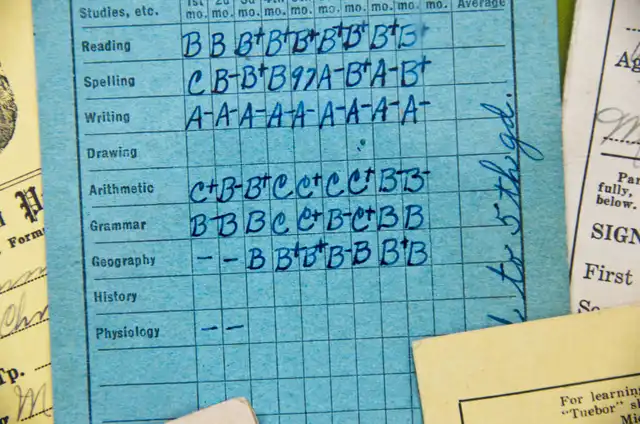- Portfolio performance for first half of 2024: +55% (+575K in portfolio dollars) compared to +1.73% for Russell 2000.
- Realized winners include BuzzFeed, Inc. and Arq, Inc., while Barnes & Noble Education was a big loser.
- The article discusses small cap and micro cap investments, and the concept of first mover advantage.
- I am Courage & Conviction Investing. I spent many years analyzing stocks at a top investing firm. I lead the investing group Second Wind Capital, where I focus on smallcap value opportunities not being discussed elsewhere.
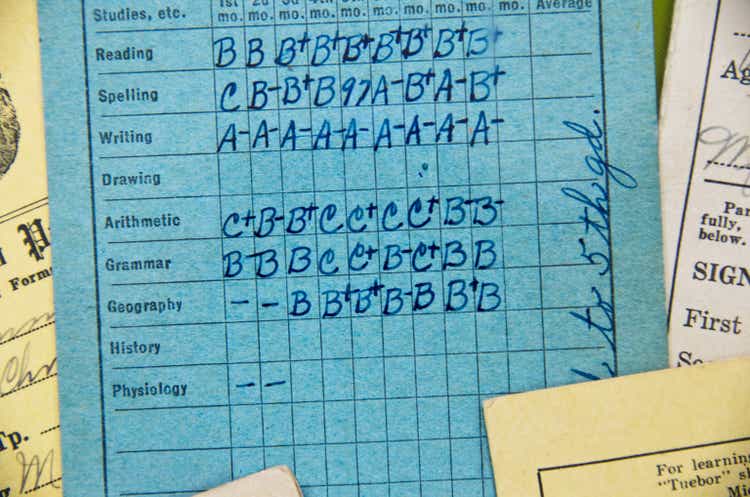
liveslow/iStock via Getty Images
It is that time of the year again, report card time. In markets, this is often measured semi-annually and annually.
As a kid, I was always a good student, as myself and my 12 cousins (on my mother’s side) used to love report card time because this prompted a visit to my grandparents’ house. Specifically, on my mother’s side, each cousin would bring their report card to my grandfather. He would go into his den and closely study each one them. Afterwards, we would be called into the den to discuss and then we got paid, based on performance, for our quarterly report cards. The lesson was doing well in school was important as he wanted to show us 1) that he cared, 2) the power of education, and 3) he emphasized he wanted us to do our best.
Back then, in elementary school and throughout middle school, we would get paid $2 for a “A”, $1.50 for each “A-,” $1 for a “B+” and $0.50 for a “B.” A B- or less didn’t generate any compensation. He might have increased the paid out ratio, as the years progressed, but I can’t precisely recall.
For context, my late grandfather grew up as an only child. Most of his life teenage life, he lived with just his dad, as he lost his mother when he was only 11. He grew up in Revere, Mass., very poor if you’re measuring only household family income. However, through the power of a sharp mind, a strong work ethic, and the G.I. bill, like millions of other Americans of that era, my grandfather moved up many rungs on the economic ladder and experienced America’s bountiful prosperity. His pathway and foothold to climber higher was going to Boston College, where he earned his undergraduate degree, Harvard for his Masters and then back to Boston College, where he earned his Phd. He was a principal for nearly 40 years and they named the middle school after him. He and his wife (my grandmother) had five children and lived a meaningful, fulfilling, and happy family life.
Now that the first half of 2024 is officially in the books, it’s time to share with readers my portfolio performance.
+55% Vs. +1.7% (Russell 2000)
I’m happy to report my total performance of +55% compared to +1.73% for the Russell 2000 (IWM).
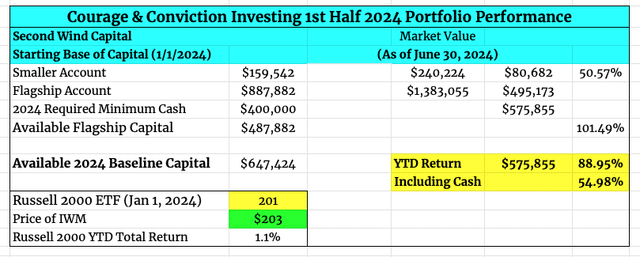
Author’s Chart
Technically, as I’ve been mandated to maintain at least $400k of cash, at all times, the total return was close to +89%. That said, what’s the difference between +89% and +55% between friends.
Enclosed below are the Fidelity Snapshot for your verification:
The Flagship Account: +495K

Fidelity
The Smaller Account: +80.6K

Fidelity
And enclosed below, as you can see, in my managed Flagship account, as of June 30, 2024, there was $487,446 in cash. Throughout the year, this mandated cash balance has fluctuated between $400K on the nose and upwards of $550K to $600K, depending on the opportunity set and how my investment committee is feeling.

Fidelity Account Balance
Either way, for reporting and simplicity purposes, let’s exclude the 400K cash mandate and simply calculate total return and overall performance inclusive of this cash. Therefore, during the first half of 2024, my total performance, again, was +55% compared to +1.73% for the Russell 2000.
Largest Realized Winners and Losers
Enclosed below, please find the largest realized winners of losers throughout the first half of 2024.
Leading the way was BuzzFeed, Inc. (BZFD), with Arq, Inc. (ARQ) just a whisker behind. In February and March 2024, I loaded up on BuzzFeed, paying an average of $1.50 per share. As luck would have it, on May 22, 2024, Vivek Ramaswamy revealed an 8% stake. That day, at the intra-day apex, BZFD share leapt to $4.53. I sold about 40% of my stake, around $4. However, since then, I bought back all of those shares back, and more, paying between $2.75 and $3.25. As for Arq, Inc., this has been the largest sized bet in my portfolio since 2023. In 2024, I aggressively averaged up, on March 13, 2024, at the opening bell, after Arq posted really strong Q4 FY 2023 numbers and commentary. I paid $4 per share that morning. And when the stock climbed to the upper $7s and low $8s (late April 2024), I sold those incremental $4 cost basis Arq shares. Like BuzzFeed, though, I bought those shares back, recently in fact, paying between $5.25 and the low $6s.
Rounding out the first half of 2024 realized winners list were The Children’s Place (PLCE), Regis Corp. (RGS), Mesa Air Group (MESA), Boston Beer Company (SAM), CuriosityStream (CURI) and Farmer Bros. Co. (FARM), which all made material contributions.
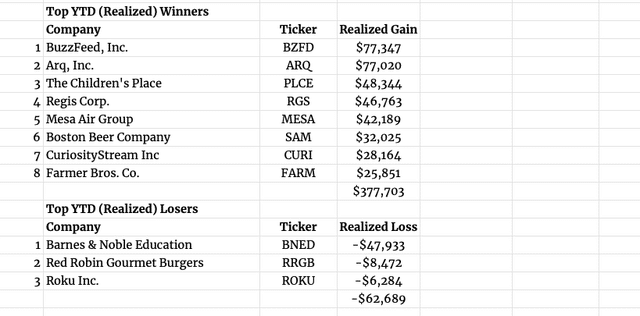
Author’s Chart
On the losing side of the ledger, I took a big loss on Barnes & Noble Education (BNED), and small losses on Red Robin Gourmet Burgers (RRGB) and Roku Inc. (ROKU).
To be clear, I still have very meaningful long positions and material unrealized gains in both BuzzFeed, Inc. as well as Arq, Inc. However, at this time, I’m not willing to share my live portfolio.
Not Reinventing The Wheel And My Process
In terms my process and how I invest, I had the pleasure of participating in three Investing Group Podcasts, with SA’s Rena Sherbill. These podcasts explain my process, if anyone is interesting in learning more.
See here:
- Small Cap Nuance With Courage & Conviction Investing (March 4, 2024)
- ‘Stay Hungry, Stay Foolish’ Small-Cap Strategies (September 27, 2023)
- Small Cap Alpha, Commodity Danger And Advanced Emissions Solutions (July 24, 2023)
These are lengthy podcasts where we get in the weeds and where I describe my small cap value and special situation investment process. At a high level, though, I mostly play in the small-cap and micro-cap sandbox, as there are so many inefficiencies there. My process is conducting old school bottoms up fundamentals analyses, talking with management teams and figuring out businesses and sectors. And then finally “trying to,” as this is art and not science, work out valuation and where we are in the cycle/ what’s the normalized EBITDA power of this business. I love turnarounds and buying stuff that is hated and left for dead. That said, this is probably about 80% art and 20% science. You need to kiss a lot frogs before you kiss a princess. I read a lot, listen to a lot of quarterly conference calls, following upwards of 300 companies, at least from a far, and synthesize fairly well. To be clear, I’m not a macro guy, I don’t pretend I can time markets, and I have a (mostly) long only basis. Occasionally, I sprinkle in a few long put ideas. A few good recent examples are Vital Farms, Inc. (VITL) (see: A Compelling Pair Trade: Long Cal-Maine Foods/ Short Vital Farms) and Cava Group (see: Wildly Overvalued) (CAVA).
I would argue that small caps/ micro caps are the best place to invest / tactical trade given the market inefficiencies. The reason is that very few buy side allocators can be involved in these companies because of the lack of liquidity / low average daily trading volumes to be able to establish a long position or exit a position. Secondly, and relatedly, even if a stock and a thesis plays out perfectly, buy side allocators want to be able to put on a $25 million to $50 million sized bet to make it worth their while. Therefore, if you do good work, and in the context of a portfolio (albeit a relatively concentrated one) and batting for a high slugging percentage, there’s no better place than small caps for generating real alpha. The reason most people aren’t involved or don’t stay committed to the small cap space is most likely due to the heightened volatility along the way and drawdown, sometimes for no good fundamental reason, which are kind of par for the course. So, it kind of goes without saying the you need healthy amount of both “courage” and “conviction” to compete in the small-cap universe. That said, you have to know when you’re wrong and be willing to take some (hopefully only occasionally) expensive medicine (losses), but only if your thesis isn’t playing out. A lot of people get hurt because they don’t know when they are wrong.
First Movers Advantage
One other aspect I want to briefly touch upon is first movers advantage. Just last week, there was a super compelling setup / opportunity in Regis Corporation (RGS).
Last week, Regis shocked the nano-cap world by pulling off an amazing and highly uncommon refinancing. Prior to this auspicious event, the company had only a $11 million market cap. and $190 million of expensive debt (SOFR +7.375%) on its balance sheet. The company’s TTM adjusted EBITDA was about $26 million. And almost all of its operating cash flow was going to pay off its interest expense. Lo and behold, at 6:30am, on July 25, Regis dropped an 8-K revealing that its former Senior Lender, Bank of America (BAC), agreed to take only $94 million in cash, from its new lender, TCW, in exchange for expunging its $190 million of Senior Secured debt.
Exhibit A: July 25 7:04am alert sent to my Investing Group members

Second Wind Capital Alert

CNBC
Exhibit B: July 25 7:04am alert sent to my Investing Group members

Second Wind Capital Alert

CNBC
Unless I have a doctor’s appointment or I’m going somewhere with my family, I’m at my post, every weekday morning, monitoring 300 company press releases, and following the news, starting at 6 a.m. – through 9 a.m. Therefore, on July 25, 2024, I saw the Regis refinancing, and I re-read the 8-K, about three times, and quickly synthesized this was a big deal and a great opportunity to make some serious money.
By 7:04 a.m., I was aggressively buying and alerting my group to strongly consider buying Regis shares, then trading between $6.25 and $6.50.
As you can see below, buying Regis shares, between $6.25 and $6.50, before 7:15 a.m., in pre-market, on July 25, 2024, was a big first movers advantage, as Regis shares opened, at 9:30 a.m., that morning, at $14.19 per share.
To be crystal clear, compelling setups like Regis might only happen, perhaps once a quarter, and you never know if/ when or exactly the setups, as they are all different and come in many difference shapes and sizes. However, this is a good example of how dynamic my process is and I was about 95% sure Regis would be filing Chapter 11 before this miracle refinancing that saved the equity.
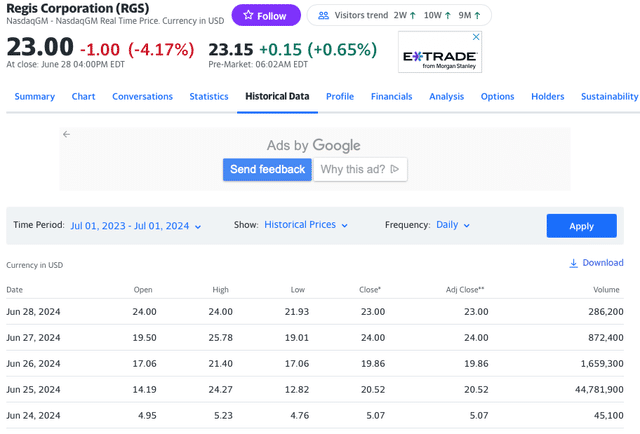
Yahoo Finance
In closing, it was a really strong first half of 2024. Despite the Russell 2000 going nowhere, volatility notwithstanding along the way. This is a great market for stock pickers and for people that work really hard at their craft and that can synthesize quickly and that can do good bottoms up/ fundamental analyses.
I’m wishing everyone much success during the second half of 2024.

